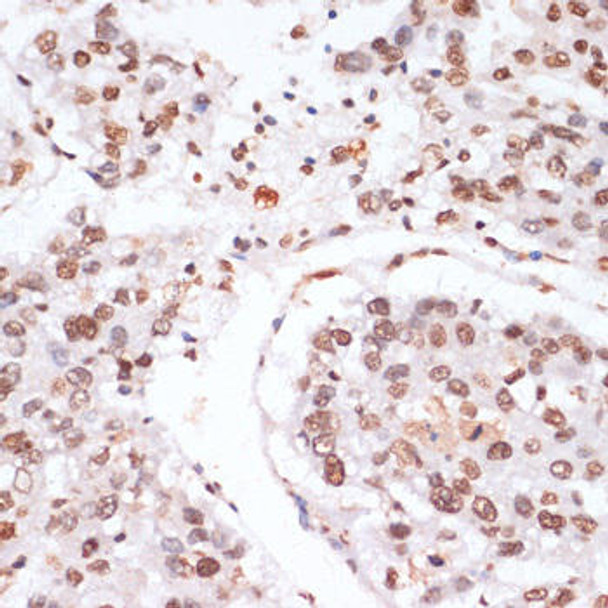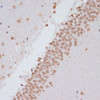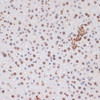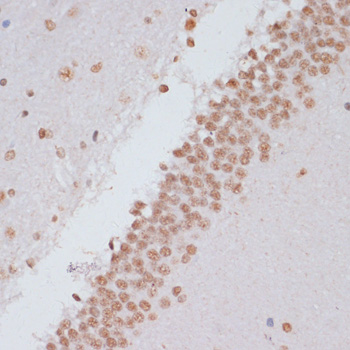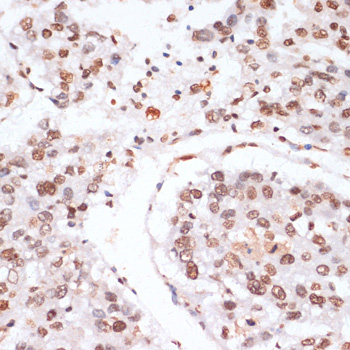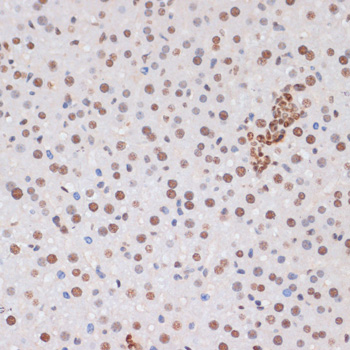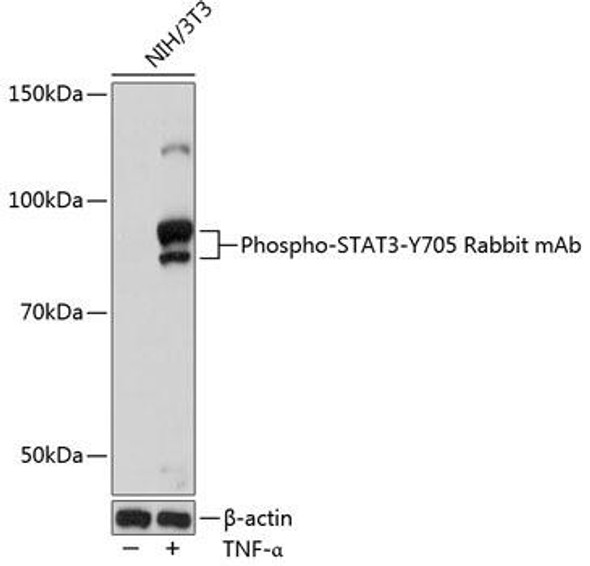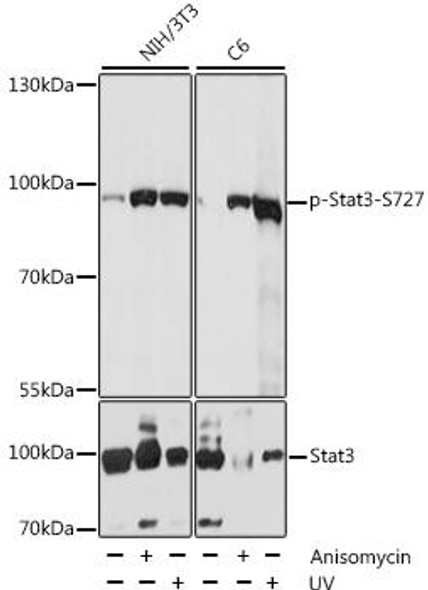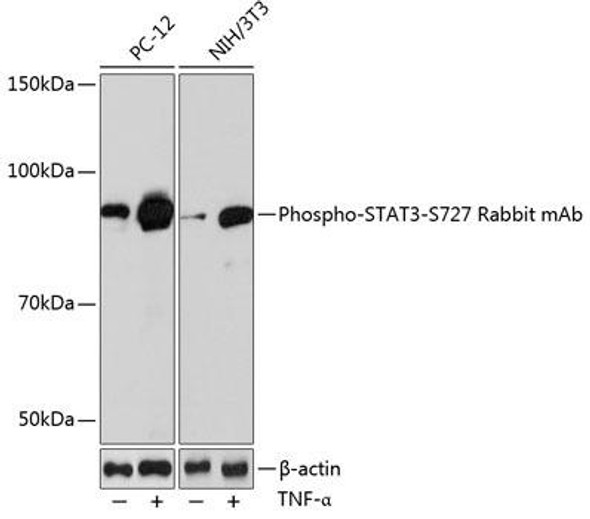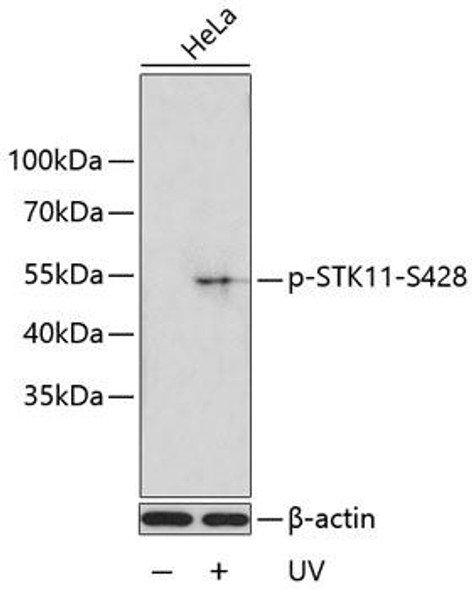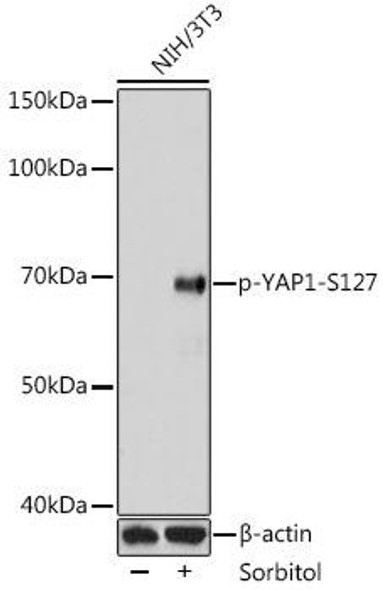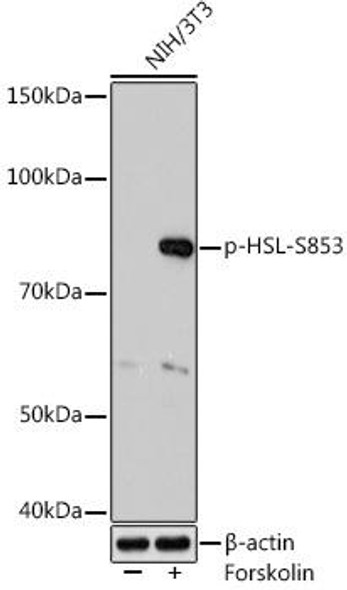Anti-Phospho-Stat3-Y705 Antibody (CABP0070)
- SKU:
- CABP0070
- Product Type:
- Antibody
- Applications:
- WB
- IHC
- IF
- Reactivity:
- Human
- Mouse
- Rat
- Host Species:
- Rabbit
- Isotype:
- IgG
- Research Area:
- Immunology
Description
Anti-Phospho-Stat3-Y705 Antibody (CABP0070)
The Phospho-STAT3 (Y705) Rabbit Polyclonal Antibody (CABP0070) is an essential tool for researchers studying the phosphorylation of STAT3 at tyrosine 705, a key signaling event involved in various cellular processes such as cell growth, differentiation, and survival. This antibody, raised in rabbits, demonstrates high specificity and sensitivity towards human samples and is validated for use in Western blot and immunohistochemistry applications.Phosphorylation of STAT3 at tyrosine 705 is known to activate its transcriptional activity, leading to the expression of genes involved in cell proliferation and survival. Dysregulation of this pathway has been implicated in various diseases, including cancer, inflammatory disorders, and immune-related conditions.
Understanding the phosphorylation status of STAT3 is crucial for unraveling its role in these pathological processes and identifying potential therapeutic targets.With its ability to specifically recognize phosphorylated STAT3 at tyrosine 705, the Phospho-STAT3 (Y705) Rabbit Polyclonal Antibody (CABP0070) is a valuable tool for researchers seeking to investigate the signaling pathways involving STAT3 activation and its impact on cellular function. This antibody is suitable for a wide range of experimental settings and provides accurate and reliable results for studies in immunology, cancer biology, and other related fields.
| Antibody Name: | Anti-Phospho-Stat3-Y705 Antibody |
| Antibody SKU: | CABP0070 |
| Antibody Size: | 20uL, 50uL, 100uL |
| Application: | WB IHC IF |
| Reactivity: | Human, Mouse, Rat |
| Host Species: | Rabbit |
| Immunogen: | A synthetic phosphorylated peptide around Y705 of human Stat3 (NP_644805.1). |
| Application: | WB IHC IF |
| Recommended Dilution: | WB 1:500 - 1:2000 IHC 1:50 - 1:200 IF 1:50 - 1:200 |
| Reactivity: | Human, Mouse, Rat |
| Positive Samples: | HeLa |
| Immunogen: | A synthetic phosphorylated peptide around Y705 of human Stat3 (NP_644805.1). |
| Purification Method: | Affinity purification |
| Storage Buffer: | Store at -20°C. Avoid freeze / thaw cycles. Buffer: PBS with 0.02% sodium azide, 50% glycerol, pH7.3. |
| Isotype: | IgG |
| Sequence: | APYL K |
| Gene ID: | 6774 |
| Uniprot: | P40763 |
| Cellular Location: | Cytoplasm, Nucleus |
| Calculated MW: | 83kDa/87kDa/88kDa |
| Observed MW: | 105kDa |
| Synonyms: | ADMIO, ADMIO1, APRF, HIES, STAT3, Stat3 |
| Background: | The protein encoded by this gene is a member of the STAT protein family. In response to cytokines and growth factors, STAT family members are phosphorylated by the receptor associated kinases, and then form homo- or heterodimers that translocate to the cell nucleus where they act as transcription activators. This protein is activated through phosphorylation in response to various cytokines and growth factors including IFNs, EGF, IL5, IL6, HGF, LIF and BMP2. This protein mediates the expression of a variety of genes in response to cell stimuli, and thus plays a key role in many cellular processes such as cell growth and apoptosis. The small GTPase Rac1 has been shown to bind and regulate the activity of this protein. PIAS3 protein is a specific inhibitor of this protein. Mutations in this gene are associated with infantile-onset multisystem autoimmune disease and hyper-immunoglobulin E syndrome. Alternative splicing results in multiple transcript variants encoding distinct isoforms. |
| UniProt Protein Function: | STAT3: transcription factor of the STAT family. Phosphorylated and activated by receptor-associated kinases downstream of many cytokines and growth-factor receptors. Constitutively active in a number of human tumors. Forms homo- or heterodimers that translocate into the nucleus where they regulate transcription. Two alternatively spliced isoforms have been described. |
| UniProt Protein Details: | Protein type:Motility/polarity/chemotaxis; Nuclear receptor co-regulator; DNA-binding; Transcription factor Chromosomal Location of Human Ortholog: 17q21.31 Cellular Component: nucleoplasm; cytoplasm; mitochondrial inner membrane; plasma membrane; nucleus; cytosol Molecular Function:protein dimerization activity; ligand-dependent nuclear receptor activity; protein binding; signal transducer activity; DNA binding; sequence-specific DNA binding; protein phosphatase binding; transcription factor binding; protein kinase binding; transcription factor activity; glucocorticoid receptor binding; CCR5 chemokine receptor binding Biological Process: transcription from RNA polymerase II promoter; viral reproduction; nerve growth factor receptor signaling pathway; somatic stem cell maintenance; positive regulation of transcription, DNA-dependent; radial glial cell differentiation; negative regulation of transcription from RNA polymerase II promoter; thermoregulation; signal transduction; glucose homeostasis; response to estradiol stimulus; negative regulation of cell proliferation; regulation of transcription, DNA-dependent; astrocyte differentiation; protein import into nucleus; acute-phase response; negative regulation of glycolysis; positive regulation of Notch signaling pathway; response to drug; nervous system development; intracellular receptor-mediated signaling pathway; eating behavior; cytokine and chemokine mediated signaling pathway; regulation of multicellular organism growth; JAK-STAT cascade; cellular response to hormone stimulus; regulation of transcription from RNA polymerase II promoter; cell proliferation; response to ethanol; sexual reproduction; positive regulation of transcription from RNA polymerase II promoter; cell motility; eye photoreceptor cell differentiation; phosphorylation Disease: Hyper-ige Recurrent Infection Syndrome, Autosomal Dominant; Autoimmune Disease, Multisystem, Infantile-onset |
| NCBI Summary: | The protein encoded by this gene is a member of the STAT protein family. In response to cytokines and growth factors, STAT family members are phosphorylated by the receptor associated kinases, and then form homo- or heterodimers that translocate to the cell nucleus where they act as transcription activators. This protein is activated through phosphorylation in response to various cytokines and growth factors including IFNs, EGF, IL5, IL6, HGF, LIF and BMP2. This protein mediates the expression of a variety of genes in response to cell stimuli, and thus plays a key role in many cellular processes such as cell growth and apoptosis. The small GTPase Rac1 has been shown to bind and regulate the activity of this protein. PIAS3 protein is a specific inhibitor of this protein. Three alternatively spliced transcript variants encoding distinct isoforms have been described. [provided by RefSeq, Jul 2008] |
| UniProt Code: | P40763 |
| NCBI GenInfo Identifier: | 48429227 |
| NCBI Gene ID: | 6774 |
| NCBI Accession: | P40763.2 |
| UniProt Secondary Accession: | P40763,O14916, Q9BW54, A8K7B8, K7ENL3, |
| UniProt Related Accession: | P40763 |
| Molecular Weight: | 770 |
| NCBI Full Name: | Signal transducer and activator of transcription 3 |
| NCBI Synonym Full Names: | signal transducer and activator of transcription 3 (acute-phase response factor) |
| NCBI Official Symbol: | STAT3 |
| NCBI Official Synonym Symbols: | APRF; HIES; ADMIO |
| NCBI Protein Information: | signal transducer and activator of transcription 3; DNA-binding protein APRF; acute-phase response factor |
| UniProt Protein Name: | Signal transducer and activator of transcription 3 |
| UniProt Synonym Protein Names: | Acute-phase response factor |
| Protein Family: | Signal transducer and activator of transcription |
| UniProt Gene Name: | STAT3 |
| UniProt Entry Name: | STAT3_HUMAN |



